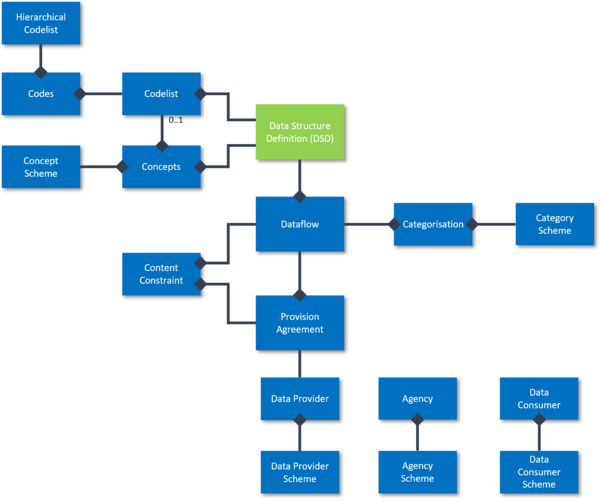Difference between revisions of "Data Structure Definition"
Jump to navigation
Jump to search
(→Context within the SDMX 2.1 Information Model) |
(→Overview) |
||
| Line 2: | Line 2: | ||
[[Category:SDMX Structures]] | [[Category:SDMX Structures]] | ||
=Overview= | =Overview= | ||
| − | An SDMX Data Structure Definition (DSD) describes the structure of a dataset in terms of its dimensions, attributes and measures. | + | <p>An SDMX Data Structure Definition (DSD) describes the structure and dimensionality of a dataset in terms of its dimensions, attributes and measures.</p> |
==Structure Properties== | ==Structure Properties== | ||
| Line 28: | Line 28: | ||
::[[File:SDMX_Information_Model_-_Core_Artefacts_-_DSD.png|600px|frameless]] | ::[[File:SDMX_Information_Model_-_Core_Artefacts_-_DSD.png|600px|frameless]] | ||
<p>The schematic illustrates the core artefacts of the SDMX 2.1 Information Model, and how the Data Structure Definition relates to other structures.</p> | <p>The schematic illustrates the core artefacts of the SDMX 2.1 Information Model, and how the Data Structure Definition relates to other structures.</p> | ||
| − | |||
| − | |||
==Usage== | ==Usage== | ||
| − | <p> | + | <p>Data Structure Definitions (DSDs) are used to describe the structure of datasets by specifying the [[Dimension|Dimensions]], [[Attribute|Attributes]] and [[Measure|Measures]]. DSDs are reusable in that each DSD can be used by multiple different [[Dataflow|Dataflows]]. This is useful where a number of different datasets need to be collected or disseminated that all share the same dimensionality and coding schemes.</p> |
| − | |||
| − | |||
Revision as of 02:29, 20 December 2019
Contents
Overview
An SDMX Data Structure Definition (DSD) describes the structure and dimensionality of a dataset in terms of its dimensions, attributes and measures.
Structure Properties
| Structure Type | Standard SDMX Structural Metadata Artefact |
|---|---|
| Maintainable | Yes |
| Identifiable | Yes |
| Item Scheme | No |
| SDMX Information Model Versions | 1.0, 2.0, 2.1 |
| Concept ID | DSD |
Context within the SDMX 2.1 Information Model
The schematic illustrates the core artefacts of the SDMX 2.1 Information Model, and how the Data Structure Definition relates to other structures.
Usage
Data Structure Definitions (DSDs) are used to describe the structure of datasets by specifying the Dimensions, Attributes and Measures. DSDs are reusable in that each DSD can be used by multiple different Dataflows. This is useful where a number of different datasets need to be collected or disseminated that all share the same dimensionality and coding schemes.
